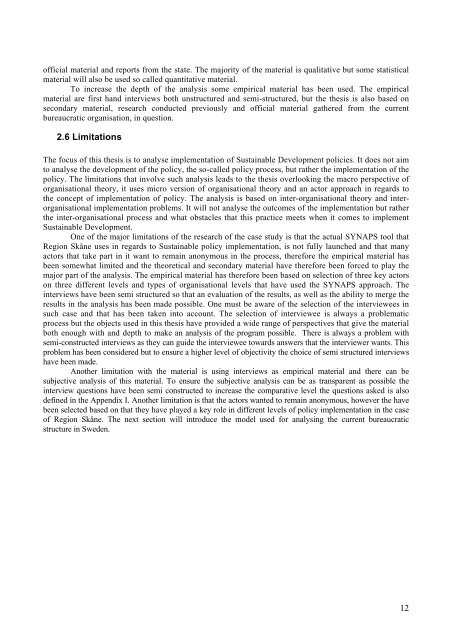From 'grey to green'- investigating the capabilities of the ... - lumes
From 'grey to green'- investigating the capabilities of the ... - lumes
From 'grey to green'- investigating the capabilities of the ... - lumes
You also want an ePaper? Increase the reach of your titles
YUMPU automatically turns print PDFs into web optimized ePapers that Google loves.
<strong>of</strong>ficial material and reports from <strong>the</strong> state. The majority <strong>of</strong> <strong>the</strong> material is qualitative but some statisticalmaterial will also be used so called quantitative material.To increase <strong>the</strong> depth <strong>of</strong> <strong>the</strong> analysis some empirical material has been used. The empiricalmaterial are first hand interviews both unstructured and semi-structured, but <strong>the</strong> <strong>the</strong>sis is also based onsecondary material, research conducted previously and <strong>of</strong>ficial material ga<strong>the</strong>red from <strong>the</strong> currentbureaucratic organisation, in question.2.6 LimitationsThe focus <strong>of</strong> this <strong>the</strong>sis is <strong>to</strong> analyse implementation <strong>of</strong> Sustainable Development policies. It does not aim<strong>to</strong> analyse <strong>the</strong> development <strong>of</strong> <strong>the</strong> policy, <strong>the</strong> so-called policy process, but ra<strong>the</strong>r <strong>the</strong> implementation <strong>of</strong> <strong>the</strong>policy. The limitations that involve such analysis leads <strong>to</strong> <strong>the</strong> <strong>the</strong>sis overlooking <strong>the</strong> macro perspective <strong>of</strong>organisational <strong>the</strong>ory, it uses micro version <strong>of</strong> organisational <strong>the</strong>ory and an ac<strong>to</strong>r approach in regards <strong>to</strong><strong>the</strong> concept <strong>of</strong> implementation <strong>of</strong> policy. The analysis is based on inter-organisational <strong>the</strong>ory and interorganisationalimplementation problems. It will not analyse <strong>the</strong> outcomes <strong>of</strong> <strong>the</strong> implementation but ra<strong>the</strong>r<strong>the</strong> inter-organisational process and what obstacles that this practice meets when it comes <strong>to</strong> implementSustainable Development.One <strong>of</strong> <strong>the</strong> major limitations <strong>of</strong> <strong>the</strong> research <strong>of</strong> <strong>the</strong> case study is that <strong>the</strong> actual SYNAPS <strong>to</strong>ol thatRegion Skåne uses in regards <strong>to</strong> Sustainable policy implementation, is not fully launched and that manyac<strong>to</strong>rs that take part in it want <strong>to</strong> remain anonymous in <strong>the</strong> process, <strong>the</strong>refore <strong>the</strong> empirical material hasbeen somewhat limited and <strong>the</strong> <strong>the</strong>oretical and secondary material have <strong>the</strong>refore been forced <strong>to</strong> play <strong>the</strong>major part <strong>of</strong> <strong>the</strong> analysis. The empirical material has <strong>the</strong>refore been based on selection <strong>of</strong> three key ac<strong>to</strong>rson three different levels and types <strong>of</strong> organisational levels that have used <strong>the</strong> SYNAPS approach. Theinterviews have been semi structured so that an evaluation <strong>of</strong> <strong>the</strong> results, as well as <strong>the</strong> ability <strong>to</strong> merge <strong>the</strong>results in <strong>the</strong> analysis has been made possible. One must be aware <strong>of</strong> <strong>the</strong> selection <strong>of</strong> <strong>the</strong> interviewees insuch case and that has been taken in<strong>to</strong> account. The selection <strong>of</strong> interviewee is always a problematicprocess but <strong>the</strong> objects used in this <strong>the</strong>sis have provided a wide range <strong>of</strong> perspectives that give <strong>the</strong> materialboth enough with and depth <strong>to</strong> make an analysis <strong>of</strong> <strong>the</strong> program possible. There is always a problem withsemi-constructed interviews as <strong>the</strong>y can guide <strong>the</strong> interviewee <strong>to</strong>wards answers that <strong>the</strong> interviewer wants. Thisproblem has been considered but <strong>to</strong> ensure a higher level <strong>of</strong> objectivity <strong>the</strong> choice <strong>of</strong> semi structured interviewshave been made.Ano<strong>the</strong>r limitation with <strong>the</strong> material is using interviews as empirical material and <strong>the</strong>re can besubjective analysis <strong>of</strong> this material. To ensure <strong>the</strong> subjective analysis can be as transparent as possible <strong>the</strong>interview questions have been semi constructed <strong>to</strong> increase <strong>the</strong> comparative level <strong>the</strong> questions asked is alsodefined in <strong>the</strong> Appendix I. Ano<strong>the</strong>r limitation is that <strong>the</strong> ac<strong>to</strong>rs wanted <strong>to</strong> remain anonymous, however <strong>the</strong> havebeen selected based on that <strong>the</strong>y have played a key role in different levels <strong>of</strong> policy implementation in <strong>the</strong> case<strong>of</strong> Region Skåne. The next section will introduce <strong>the</strong> model used for analysing <strong>the</strong> current bureaucraticstructure in Sweden.12
















